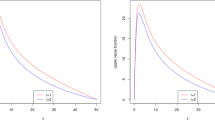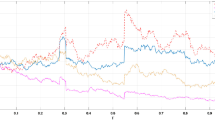Abstract
In this paper, we consider a market model with prices and consumption following a jump-diffusion dynamics. In this setting, we first characterize the optimal consumption plan for an investor with recursive stochastic differential utility on the basis of his/her own beliefs, then we solve the inverse problem to find what beliefs make a given consumption plan optimal. The problem is viewed in general for a class of homogeneous recursive utility, and later we choose a logarithmic model for the utility aggregator as an explicitly computable example. When beliefs, represented via Girsanov’s theorem, get incorporated into the model, the change of measure gives rise, up to a transformation, to a backward stochastic differential equation whose generator exhibits a quadratic behavior in the Brownian component and a locally Lipschitz one in the jump component, which is solvable on the basis of some recent results.
Similar content being viewed by others
References
Antonelli, F.: Backward–forward stochastic differential equations. Ann. Appl. Prob. 3(3), 777–793 (1993)
Antonelli, F., Mancini, C.: Solutions of BSDE’s with jumps and quadratic/locally Lipschitz generator. Stoch. Process. Appl. (2016). doi:10.1016/j.spa.2016.04.004
Becherer, D.: Bounded solutions to backward SDE’s with jumps for utility optimization and indifference hedging. Ann. Appl. Prob. 16(4), 2027–2054 (2006)
Cont, R., Tankov, P.: Financial Modelling with Jump Processes. Chapman & Hall, London (2004)
Duffie, D., Epstein, L.: Stochastic differential utility. Econometrica 60(2), 353–394 (1992)
Hu, Y., Peng, S.: Solution of forward–backward stochastic differential equations. Prob. Theory Relat. Fields 103(2), 273–283 (1995)
Lazrak, A., Zapatero, F.: Efficient consumption set under recursive utility and unknown beliefs. J. Math. Econ. 40(1–2), 207–226 (2004)
Protter, P.: Stochastic Integration and Differential Equations, 2nd edn. Stochastic Modelling and Applied Probability, vol. 21. Springer, Berlin, Heidelberg (2005)
Schroder, M., Skiadas, C.: Optimal consumption and portfolio selection with stochastic differential utility. J. Econ. 89(1), 68–126 (1999)
Schroder, M., Skiadas, C.: Optimal lifetime consumption–portfolio strategies under trading constraints and generalized recursive preferences. Stoch. Process. Appl. 108(2), 155–202 (2003)
Schroder, M., Skiadas, C.: Optimality and state pricing in constrained financial markets with recursive utility under continuous and discontinuous information. Math. Finance 18(2), 199–238 (2008)
Situ, R., Yin, J.: On solutions of forward–backward stochastic differential equations with poisson jumps. Stoch. Anal. Appl. 21(6), 1419–1448 (2003)
Author information
Authors and Affiliations
Corresponding author
Appendix: Existence and uniqueness results
Appendix: Existence and uniqueness results
In this appendix, we recall the existence and uniqueness result in Antonelli and Mancini (2016) and we show that we can apply it to solve our equation in Theorem 2.
We assume the same notation as in Sect. 2. We take a bounded \(\mathscr {F}_T-\)measurable r.v. \(\xi \) and a predictable process \(l_s(y,z,u,q)\) continuous in (y, z, u, q), locally Lipschitz in y, Lipschitz in z and increasing in q and we set \( L_s(y,z,u)=l_s(y,z,u,z^2) \).
We assume that \(\mathbb {P}-\)a.s.
where \(b_1,b_2>0\), \(\{a_t\}_{t\in [0,T]}\) is a strictly positive predictable process bounded below by \(\frac{b_1}{b_2}\), so that \(\displaystyle ||[a||_{\text {int}}:= ||\alpha ||_{\text {int}}:= \text {essup}_{\omega }\int _0^T \alpha _s \hbox {d}s< +\infty \) and for any \(b \in {\mathbb {R}}\), we denoted
Finally we suppose that
where \(\tau ^{y,z,u,u^{\prime }}_s:{\varOmega }\times [0,T]\times E\longrightarrow \mathbb {R}\) is \(\mathscr {F}\times \mathcal {B}([0,T])\times \mathcal {B}(E)-\)measurable, such that \(D_1\le \tau ^{y,z,u,u^{\prime }}_s(e)\le D_2\) with \(-1< D_1\le 0\) and \(D_2\ge 0\), for all \(s,y,z,u,u^{\prime },e\), then exists \((Y,Z,U)\in \mathcal {S}^{\infty }\times \mathcal {L}^2\times \mathcal {L}^2({\tilde{N}})\) solution of
so that \(||Y||_\infty <K_1, \, \Vert Z\Vert _{\mathcal {L}^2}\le K_1; \,\, \Vert U\Vert _{\mathcal {L}^2({\tilde{N}})}\le K_3 \) with positive constants \(K_1,K_2, K_3\) depending only on \(\Vert \xi \Vert _{\infty },[\alpha ]_{\text {int}} , b_1,b_2, T\).
Uniqueness is achieved if we add that
for some constant \(C>0\) and some predictable process k such that \(\int _0^\cdot k_s \hbox {d}W_s\) is a BMO martingale.
We recall that
Definition 1
A martingale M is said to be in the class of BMO martingales (bounded mean oscillation) if there exists a constant \(C>0\), such that
where \(\mathcal {T}\) is the set of all \(\mathscr {F}_t-\)stopping times in [0, T] and \(<M>\) denotes the continuous part of the quadratic variation of the martingale.
Proof of Theorem 2
To show the existence and uniqueness of the solution of Eq. (19), we first transform it into an equivalent BSDE.
For any \(b\in {\mathbb {R}}\) let us denote by \(\varphi _b(u):=\frac{\mathrm e^{b u}-1-b u}{b}\) so that \(\displaystyle [[u]]_b = \int _E \varphi _b(u(e))\gamma (\hbox {d}e). \) Setting \(G_t:=-\ln (V_t)\), \(M_t=-\frac{Z_t}{V_{t-}}\) and \(J_t(e)=-\ln \Big (1+\frac{U_t(e)}{V_{t-}}\Big )\) and applying formally Itô’s formula, we get
that is a BSDE with bounded terminal value \(-\ln (1+F(c_T))\) and generator
Since \(\iota \in (0,1)\) and \(\theta \in (-1+\epsilon ,0)\), \(0<(1-\iota )(1+\theta )<1\), we can say that
with \(\kappa \) such that \(\beta (|\ln c|+\kappa )\ge \beta \). Moreover, given \(p\ge \frac{2\mathrm e^{\beta T}}{\beta }\), we have that
but c is a stochastic exponential and the integrability of \(c^p\) and \(c^{-p}\) is ensured by hypothesis (17).
Moreover \(L_t(g,m,j)\) is Lipschitz in g, increasing in \(m^2\) and, by virtue of the boundedness hypotheses on \(\iota \) and \(\theta \) and the mean value theorem applied to \(\varphi _1\), it verifies
for \(j,j^{\prime }\in L^2(\gamma )\), where \(\tau ^{g,m,j,j^{\prime },\iota ,\theta }_s\) is such that \(D_1\le \tau ^{g,m,j,j^{\prime },\iota ,\theta }_s(e)\le D_2\) with \(-1< D_1\le 0\) and \(D_2\ge 0\) for all \(s,g,m,j,j^{\prime },\iota ,\theta ,e\). Thus we can apply the above result to say that there exists a solution for the BSDE (21).
Finally noting that
we obtain also the uniqueness of the solution.
Consequently there exists a unique solution also for Eq. (19). \(\square \)
Rights and permissions
About this article
Cite this article
Antonelli, F., Mancini, C. Consumption optimization for recursive utility in a jump-diffusion model. Decisions Econ Finan 39, 293–310 (2016). https://doi.org/10.1007/s10203-016-0177-1
Received:
Accepted:
Published:
Issue Date:
DOI: https://doi.org/10.1007/s10203-016-0177-1




